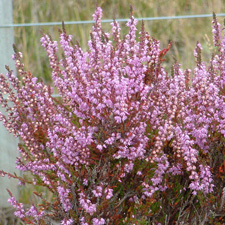 Heather
Heather
Common name: Heather
Botanical name: Calluna vulgaris
Management category: Advisory
Originally from Europe and North Africa. It was introduced to New Zealand as an ornamental species and was recorded as naturalised in 1910.
Why is it a pest?
- Rapidly forms dense stands, suckers and seeds profusely, grows much faster than its subalpine competitors.
- Prevents the establishment of native species and tolerates cold, high and low rainfall and poor soils.
Where is it found?
Shrubland, short tussock land, bare land, montane wetlands and riverbeds mostly in colder, subalpine areas with acid soils.
What does it look like?
- Bushy evergreen tough shrub with woody, wiry stems and densely hairy young shoots becoming hairless as they mature.
- Long dark green to brown leaves are in opposite pairs on the stem, overlapping in four vertical rows.
- Bell-shaped, pink to pale purple flowers on narrow, leafy, elongated, upright clusters (December to March) are followed by tiny, round, hairy seed capsules.
What are the rules?
Advisory
Council does not enforce the control of advisory species. It is landowner/occupier responsibility to manage these pests. Council may provide advice on how to manage or control advisory species if required.
How do you get rid of it?
- Cut and Paste (all year) – Glyphosate + Metsulfuron or Picloram gel.
- Spray (Spring only) – 2,4-D butyl ester.
CAUTION: When using any herbicide or pesticide, PLEASE READ THE LABEL THOROUGHLY to ensure that all instructions and directions for the purchase, use and storage of the product, are followed and adhered to.
Read more on pest control advice, information and regulations.
